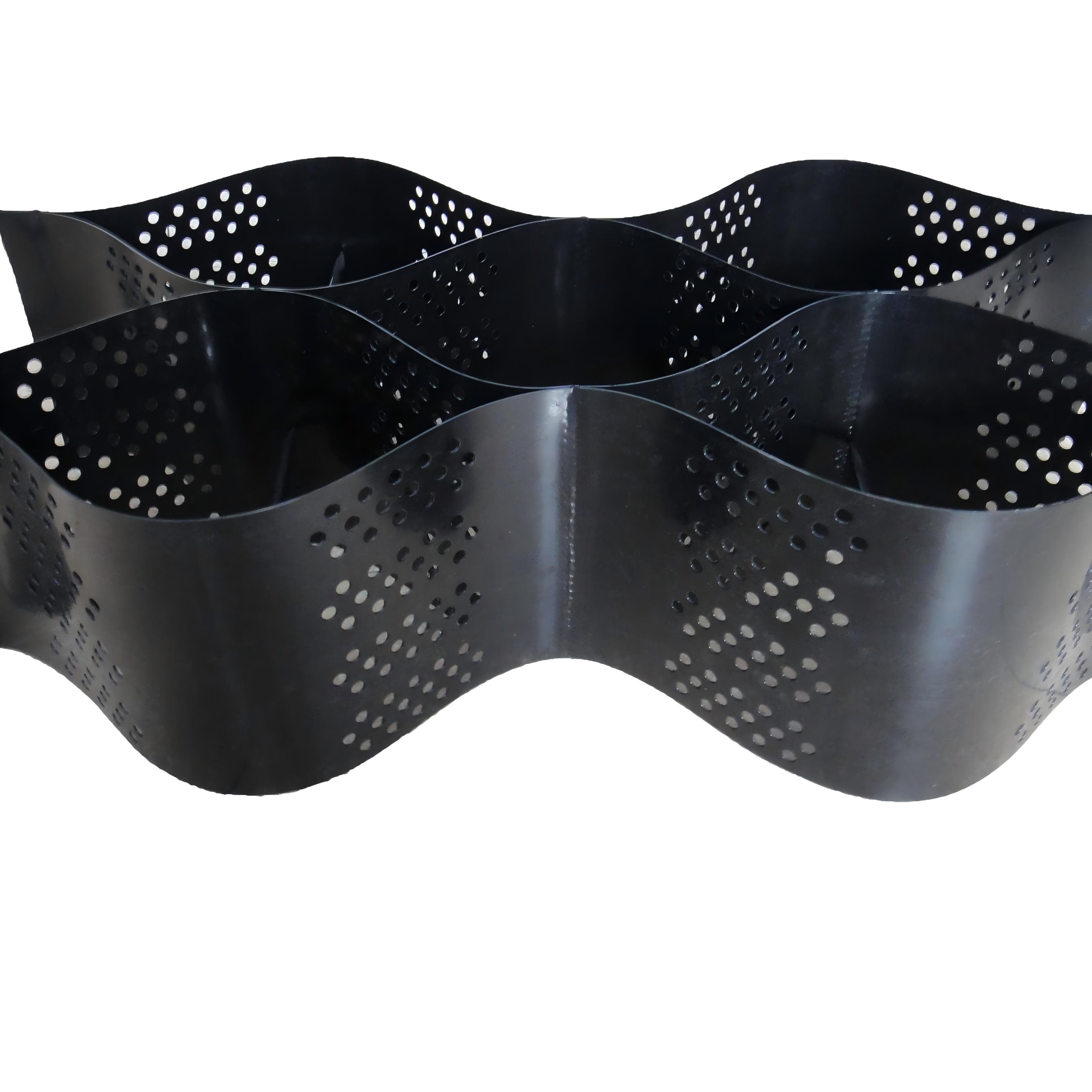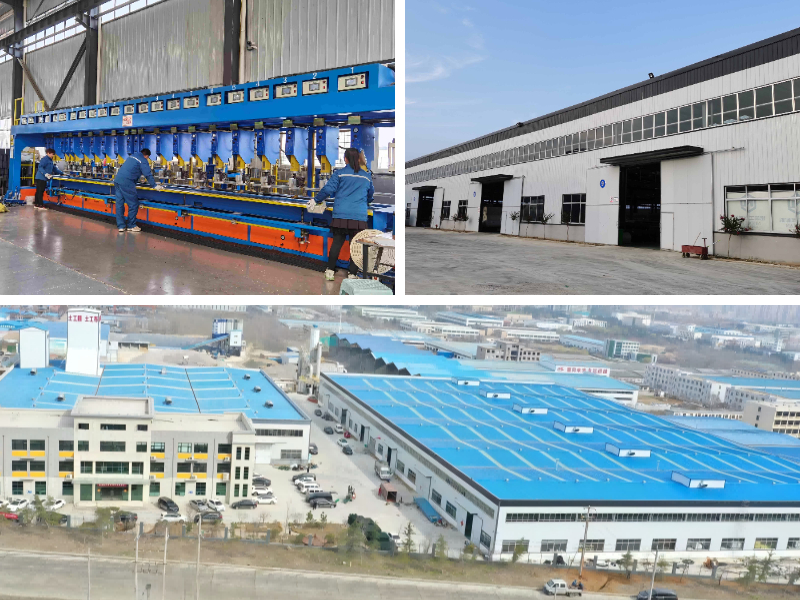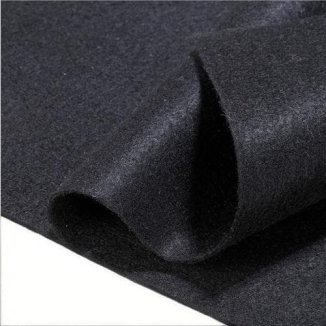Slope Protection Geocell
1.Significant structural strengthening:Honeycomb grid constrains soil, enhances foundation bearing capacity and slope stability, and suppresses sliding settlement.
2.Flexible and efficient construction:Flexible splicing, adaptable to complex terrain, lightweight design for easy transportation and laying, shortening construction period.
3.Durable and environmentally friendly:High strength material is acid and alkali resistant, anti-aging, and suitable for harsh environment; The materials are recyclable and there is no dust during construction.
4.Wide scene adaptation:Suitable for roadbed reinforcement, slope protection, river treatment, etc., with both soil and water conservation and structural strengthening functions.
Product Introduction
Basic attributes
Slope Protection Geocell is a three-dimensional honeycomb structure product made from high-strength polymers such as high-density polyethylene and polypropylene, processed through special processes such as extrusion, stretching, and welding. After unfolding, a single set of grid cells takes on a hexagonal or diamond grid shape, and the grid size can be flexibly adjusted according to engineering requirements. A single product can be folded and stored to less than 1/10 of its original volume, saving space during transportation. The material itself has undergone UV and corrosion resistance treatment. Not easily brittle and cracked in a temperature difference environment of -40 ℃ to 60 ℃. It has excellent acid and alkali resistance, anti-aging chemical stability, and can adapt to soil, water and other complex media environment
Core functions
By utilizing honeycomb shaped grids to form a three-dimensional spatial constraint effect on the filled soil, the loose soil is transformed into an overall load-bearing structure by restricting the lateral displacement of soil particles, thereby significantly improving the foundation bearing capacity (which can increase the foundation bearing capacity by 30% -50%) and the overall stability of the slope. In slope protection, it can effectively disperse the self weight of soil and external load pressure, and prevent geological disasters such as landslides and collapses; At the same time, the grid structure can intercept surface runoff, slow down the erosion speed of water flow, and further enhance the soil and water conservation effect with vegetation planting, reducing soil erosion by more than 60% and providing long-term safety protection for engineering structures.
Main features
Construction convenience: The weight of a single set of products is only 1/5 of traditional rigid support materials, and can be easily transported manually; The grid units are assembled using snap fasteners or hot melt welding, without the need for large mechanical assistance. They can be quickly laid in complex terrains such as slopes, gullies, and soft foundations, and can shorten the construction period by more than 40% compared to traditional support processes;
Durable and environmentally friendly: The main material has a fracture tensile strength of over 20MPa, and the weather resistance test can meet the requirement of a service life of over 50 years; The materials can be recycled and reused, and there is no dust or noise pollution during the construction process, avoiding the waste of resources in traditional concrete construction and fully complying with green engineering environmental protection standards;
Widely applicable scenarios: It can reduce roadbed settlement in highway and railway roadbed reinforcement, assist in soil fixation and vegetation restoration inmine greening projects, balance embankment protection and ecological restoration in river management, and is widely used in airport runway base treatment, municipal green belt slope protection and other scenarios, with outstanding functional practicality and scene compatibility.
Product Parameters
order number | raw and processed material | |||||||
test item | unit | polytene | sulan | polyester | ||||
Extruded type | Stretch type | Extruded type | Stretch type | Extruded type | Stretch type | |||
1 | tensile strength | kN/m | ≥20 | ≥100 | ≥23 | ≥100 | ≥30 | ≥120 |
2 | Tensile yield strain | % | ≤15 | — | ≤15 | — | ≤15 | - |
3 | Tensile fracture strain | % | — | 8~ 20 | — | 6~ 15 | — | 8~ 20 |
4 | Carbon black content a | % | 2. 0~ 3. 0 | |||||
5 | Carbon black dispersion a | — | There should be no more than one level 3 data item in ten data items and no level 4 or 5 data items | |||||
6 | 200℃ oxidation induction time | min | ≥20 | ≥20 | — | |||
7 | Tensile load stress cracking | h | ≥300 | — | ||||
8 | B. Resistance to artificial climate aging retention rateb | % | ≥80 | |||||
9 | Chemical resistance performance retention rate c | % | — | ≥80 | ||||
Product Application
1、 Road engineering field
Roadbed reinforcement and settlement control: In soft soil foundation sections, geogrids are laid at the base of the roadbed, and the lateral displacement of fill particles is constrained by grid elements to improve the bearing capacity of the roadbed and reduce uneven settlement. Especially suitable for scenarios such as high fill roadbeds and bridge head collision prevention.
Pavement base reinforcement: Laying geogrids in the pavement base (such as sand and gravel base, cement stabilized base) can disperse vehicle loads, delay base cracking, and extend the service life of the pavement. It is commonly used for upgrading and renovating low-grade roads such as rural roads and mining area roads.
Slope anti-skid and shoulder protection: Lay geogrids and fill them with soil and rock at road slopes or shoulders to form a stable structural layer, prevent slope collapse and shoulder collapse caused by rainwater erosion, and enhance the safety along the road.
2、 In the field of water conservancy and geotechnical engineering
River and channel management: Geogrid cells are laid on the bank slopes of rivers and channels, combined with vegetation planting or block stone filling, to form anti erosion structures, reduce water erosion on slopes, protect river bank stability, and take into account ecological landscape effects.
Dam anti-seepage and reinforcement: Laying geogrids during the dam filling process can improve the overall integrity of the dam structure, reduce the risk of dam deformation and leakage, and is particularly suitable for the repair and reinforcement of small and medium-sized water conservancy dams.
Retaining Wall and Supporting Structure: A flexible retaining wall is formed by combining geogrids with fill soil, replacing traditional masonry or concrete retaining walls, reducing construction costs, and being convenient to construct. It is suitable for slope support scenarios with complex terrain.
3、 In the field of ecology and environmental restoration
Mine greening and slope management: Geogrid cells are laid on the exposed slopes formed by mining, filled with soil and vegetation seeds, to quickly restore slope vegetation coverage, prevent soil erosion and geological disasters, and achieve ecological restoration.
Desertification and Saline alkali Land Improvement: In areas of desertification or saline alkali land, soil improvement is achieved by constraining soil through geogrids, reducing wind erosion and water evaporation, creating a stable environment for vegetation growth, and assisting in land ecological restoration.
Landfill anti-seepage layer protection: Laying geogrids above the anti-seepage layer of the landfill can protect the anti-seepage membrane from damage during subsequent filling construction, while enhancing the stability of the landfill body.
4、 Other special engineering fields
Strengthening of airport runway and apron foundation: laying geogrids on the base layer of airport runway or apron to improve the bearing capacity and deformation resistance of the foundation, and reduce the fatigue damage of the base layer caused by aircraft loads.
Prevention and control of railway subgrade diseases: In response to diseases such as mud boiling and uneven settlement of railway subgrade, geogrids are used for reinforcement treatment to improve subgrade stability and ensure railway operation safety.
Temporary engineering and emergency rescue: In temporary roads, emergency passages, and other engineering projects, geogrids can quickly achieve foundation reinforcement, meet short-term load requirements, and are suitable for emergency scenarios such as rescue and disaster relief.
The honeycomb constraint system plays an irreplaceable role in many engineering fields such as roads, water conservancy, ecological restoration, and transportation hubs, thanks to its core advantages of lightweight, high strength, easy construction, and ecological compatibility. It not only effectively solves technical problems such as foundation settlement, slope instability, and soil erosion in traditional engineering, but also reduces project costs, shortens construction periods, and meets the dual needs of ecological protection and engineering safety. With the continuous development of engineering technology, the material properties of honeycomb constraint systems continue to be optimized, and their application scenarios are constantly expanding, becoming an important new material for improving structural stability and promoting ecological construction in modern civil engineering. The future application prospects will be even b roader.












